| Revision as of 14:38, 11 May 2023 editAnomieBOT (talk | contribs)Bots6,575,216 editsm Dating maintenance tags: {{Fact}}← Previous edit |
Latest revision as of 05:46, 9 January 2025 edit undoGray eyes (talk | contribs)Extended confirmed users30,541 edits →External links |
| (8 intermediate revisions by 8 users not shown) |
| Line 1: |
Line 1: |
|
|
{{Short description|Historic District of Panama City in Panama}} |
|
{{Expand Spanish|date=December 2011|Casco Antiguo de Panamá}} |
|
{{Expand Spanish|topic=geo|date=December 2011|Casco Antiguo de Panamá}} |
|
|
{{for|the neighborhood in Bilbao|Casco Viejo}} |
|
{{Infobox settlement |
|
{{Infobox settlement |
|
| name = Casco Antiguo |
|
| name = Casco Antiguo |
| Line 62: |
Line 64: |
|
Panama City was founded on August 15, 1519 and it lasted one hundred and fifty-two years. In January 1671, the Governor Juan Perez de Guzman had it set on fire,{{fact|date=May 2023}} before the attack and looting by the pirate ]. In 1672, Antonio Fernández de Córdoba initiated the construction of a new city, which was then founded on January 21, 1673. This city was built on a peninsula completely isolated by the sea and a defensive system of walls.<ref name=CASTILLERO>{{cite book|last1=Castillero|first1=Alfredo|title=UNESCO Guides: Panamá la Vieja and Casco Viejo|year=2004|publisher=UNESCO Publishing|isbn=92-3-103923-7}}</ref> Today this place preserves the first institutions and buildings of the modern city of Panama. It is known as ''Casco Viejo'' (Spanish for Old Town). |
|
Panama City was founded on August 15, 1519 and it lasted one hundred and fifty-two years. In January 1671, the Governor Juan Perez de Guzman had it set on fire,{{fact|date=May 2023}} before the attack and looting by the pirate ]. In 1672, Antonio Fernández de Córdoba initiated the construction of a new city, which was then founded on January 21, 1673. This city was built on a peninsula completely isolated by the sea and a defensive system of walls.<ref name=CASTILLERO>{{cite book|last1=Castillero|first1=Alfredo|title=UNESCO Guides: Panamá la Vieja and Casco Viejo|year=2004|publisher=UNESCO Publishing|isbn=92-3-103923-7}}</ref> Today this place preserves the first institutions and buildings of the modern city of Panama. It is known as ''Casco Viejo'' (Spanish for Old Town). |
|
|
|
|
|
|
In the 18th century this part of the city was the victim of three large fires that partially destroyed it and modified its initial structure. The current configuration dates from the end of the 19th century and the first half of the 20th century. <ref>{{cite book|date=2010 |publisher=Ediciones Balboa |title=Ciudad de Panamá, cinco siglos de historia}}<!-- auto-translated from Spanish by Module:CS1 translator --></ref> The recostruction allows the insertion of neoclassical, Afro-Antillean buildings within the ruins and colonial buildings, which differentiates it from other old towns in cities such as Cartagena de Indias and Quito, which have an almost exclusively colonial style. |
| ⚫ |
In recent years, Casco Viejo— through gentrification— has become a tourist hotspot filled with restaurants, boutique hotels, and nightclubs; while also maintaining the multiple historical sites it has to offer.<ref>{{Cite web|title=The Gentrification of Casco Viejo, Panama – Salt Trails|url=http://salttrails.com/the-gentrification-of-casco-viejo-panama/|access-date=2021-03-04|website=salttrails.com}}</ref><ref>{{Cite web|last=Gold|first=David|title=Nightlife in Casco Viejo|url=https://cascospanish.com/nightlife-in-casco-viejo/|access-date=2021-03-04|website=Casco Antiguo Spanish School|language=en-US}}</ref> |
|
|
|
|
|
⚫ |
In recent years, Casco Viejo— through gentrification— has become a tourist hotspot filled with restaurants, boutique hotels, and nightclubs; while also maintaining the multiple historical sites it has to offer.<ref>{{Cite web|title=The Gentrification of Casco Viejo, Panama – Salt Trails|url=http://salttrails.com/the-gentrification-of-casco-viejo-panama/|access-date=2021-03-04|website=salttrails.com|archive-date=2021-05-16|archive-url=https://web.archive.org/web/20210516185417/http://salttrails.com/the-gentrification-of-casco-viejo-panama/|url-status=dead}}</ref><ref>{{Cite web|last=Gold|first=David|title=Nightlife in Casco Viejo|url=https://cascospanish.com/nightlife-in-casco-viejo/|access-date=2021-03-04|website=Casco Antiguo Spanish School|language=en-US}}</ref> |
|
|
|
|
|
==Main sights== |
|
==Main sights== |
|
*La Catedral Metropolitana is the main Catholic church in Panama city. |
|
*] is the main Catholic church in Panama city. |
|
*], is the governmental office and residence of the ]. |
|
*], is the governmental office and residence of the ]. |
|
*Church and Convent of ]. |
|
*Church and Convent of ]. |
| Line 127: |
Line 131: |
|
{{Authority control}} |
|
{{Authority control}} |
|
|
|
|
|
] |
|
] |
|
] |
|
] |
|
] |
|
] |
Panama City was founded on August 15, 1519 and it lasted one hundred and fifty-two years. In January 1671, the Governor Juan Perez de Guzman had it set on fire, before the attack and looting by the pirate Henry Morgan. In 1672, Antonio Fernández de Córdoba initiated the construction of a new city, which was then founded on January 21, 1673. This city was built on a peninsula completely isolated by the sea and a defensive system of walls. Today this place preserves the first institutions and buildings of the modern city of Panama. It is known as Casco Viejo (Spanish for Old Town).
In the 18th century this part of the city was the victim of three large fires that partially destroyed it and modified its initial structure. The current configuration dates from the end of the 19th century and the first half of the 20th century. The recostruction allows the insertion of neoclassical, Afro-Antillean buildings within the ruins and colonial buildings, which differentiates it from other old towns in cities such as Cartagena de Indias and Quito, which have an almost exclusively colonial style.
In recent years, Casco Viejo— through gentrification— has become a tourist hotspot filled with restaurants, boutique hotels, and nightclubs; while also maintaining the multiple historical sites it has to offer.
 Aerial Panorama (Casco Antiguo)
Aerial Panorama (Casco Antiguo) Location of San Felipe(Casco Antiguo) in Panamá province
Location of San Felipe(Casco Antiguo) in Panamá province
 Panama Canal Museum
Panama Canal Museum
Plaza de la Independencia
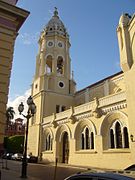 San Francisco de Asís Church
San Francisco de Asís Church
 Inside San Francisco de Asís Church
Inside San Francisco de Asís Church
 National Theater
National Theater
 Inside the National Theater
Inside the National Theater
 Society of Jesus
Society of Jesus
 Convento de Santo Domingo
Convento de Santo Domingo
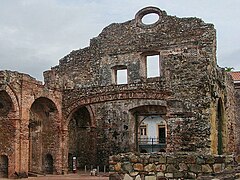 Arco Chato
Arco Chato
 San José Church
San José Church
 Typical houses
Typical houses
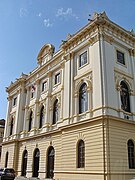 Palacio Nacional
Palacio Nacional
 Palacio de las Garzas
Palacio de las Garzas
Casa Góngora
 Catedral Metropolitana
Catedral Metropolitana
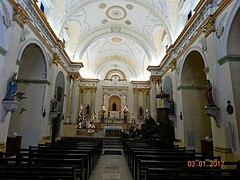 Inside the Catedral Metropolitana
Inside the Catedral Metropolitana
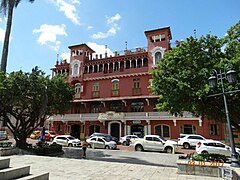 Plaza Bolivar
Plaza Bolivar
 Map of Panama and its suburb in 1789
Map of Panama and its suburb in 1789
Plaza Herrera
 Panama City view from Casco Viejo
Panama City view from Casco Viejo
 (in Spanish)
(in Spanish)